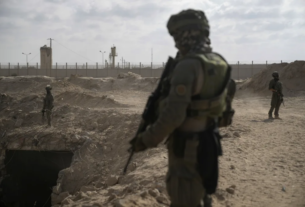By Lumine
JERUSALEM, In a move signaling escalating regional tensions and shifting military priorities, Israel’s defense spending surged by 65% in 2024, the largest annual increase since the Six-Day War, according to a new report from the Stockholm International Peace Research Institute (SIPRI). The country’s military budget soared to $46.5 billion, or 8.8% of its GDP, ranking second-highest globally in terms of GDP share.
This unprecedented increase comes amid the ongoing war in Gaza and intensifying hostilities across Israel’s northern and southern borders. The report identifies Israel as the most aggressive defense spender in the Middle East for 2024, with Lebanon trailing at a distant second, having increased its defense budget by 58% after years of stagnation due to economic collapse.
“We are witnessing the most aggressive military rearmament in the region in decades,” said Zubaida Karim, a researcher with SIPRI’s Military Expenditure and Arms Production Programme. “Israel’s 65% jump is not just a budget shift, it’s a signal.”
Total military spending across the Middle East climbed to $243 billion, a 15% increase from 2023, driven largely by the Gaza conflict. However, SIPRI notes that only Israel and Lebanon experienced major spending hikes, while other states were limited by economic instability or political hesitancy.
In contrast, Iran’s defense budget fell by 10% to $7.9 billion, due to crippling sanctions, despite its involvement in proxy conflicts.
“Sanctions have left Tehran with big ambitions and shallow pockets,” Karim added.
The SIPRI report places the Middle East spike in a global context:
- Global military spending reached a record $2.718 trillion, a 9.4% increase, the steepest year-on-year rise since before the Cold War’s end.
- The top five global spenders, the U.S., China, Russia, Germany, and India, accounted for 60% of the total.
- Russia’s military budget surged 38% to $149 billion, nearly double its 2015 figure.
- Ukraine spent 34% of its GDP on defense, the highest in the world.
The United States alone spent $997 billion, representing 37% of global military spending and 66% of NATO’s total. A large portion of that budget is focused on nuclear modernization and maintaining strategic advantage over China and Russia.
Meanwhile, China’s defense spending grew by 7% to $314 billion, continuing a 30-year trend of expansion, particularly in cyberwarfare and nuclear programs.
“This arms race in Asia-Pacific could spiral dangerously,” warned SIPRI’s Nan Tian.
In the Middle East, Saudi Arabia remained the largest spender, allocating $80.3 billion to defense, placing it seventh globally.With geopolitical uncertainty rising and armed conflicts intensifying, SIPRI warns that global focus is shifting toward militarization, a trend that could undermine social and economic development for years to come.



